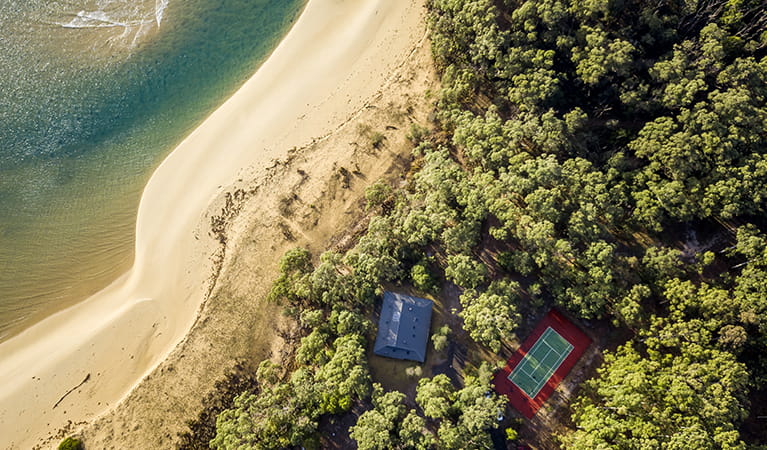Myer House
Mimosa Rocks National Park
Overview
Historic Myer House offers boutique self-contained accommodation set on Bithry Inlet near Lake Wapengo in Mimosa Rocks National Park.
| Accommodation type | House |
|---|---|
| Where | 97 Middle Beach Road, Tanja, NSW, 2550 - in Mimosa Rocks National Park |
| Bedrooms | 4 |
| Maximum guests | 12 |
| Facilities | Picnic tables, barbecue facilities, public phone, showers, toilets, electric power, indoor fireplace, kitchen, plates and cutlery, pots and pans, bed linen, bath, tv, washing machine |
| What to bring | Food supplies, toilet paper, towels |
| Please note |
|
Myer House is set in a lovely secluded coastal location within Mimosa Rocks National Park. Offering self-contained accommodation for up to 12 people, this beautifully-restored house overlooks Bithry Inlet, the mouth of Wapengo Lake, a pristine South Coast estuary.
Kenneth Myer of the Myer Foundation built this house from a design by renowned architect Sir Roy Grounds, and they generously donated it to NPWS in 1976.
A harmonious combination of old and new, the authentically-restored historical building offers all the modern conveniences you would need, including entertainment and kitchen facilities.
Tumble out of bed and right onto the beach to enjoy breakfast, or take a walk through the nearby eucalypt plantation. You could even enjoy a spot of tennis at Myer House tennis court. And, for an evening to remember, feast upon fresh Wapengo oysters while taking in the beach sunset over a glass of champagne.
Map
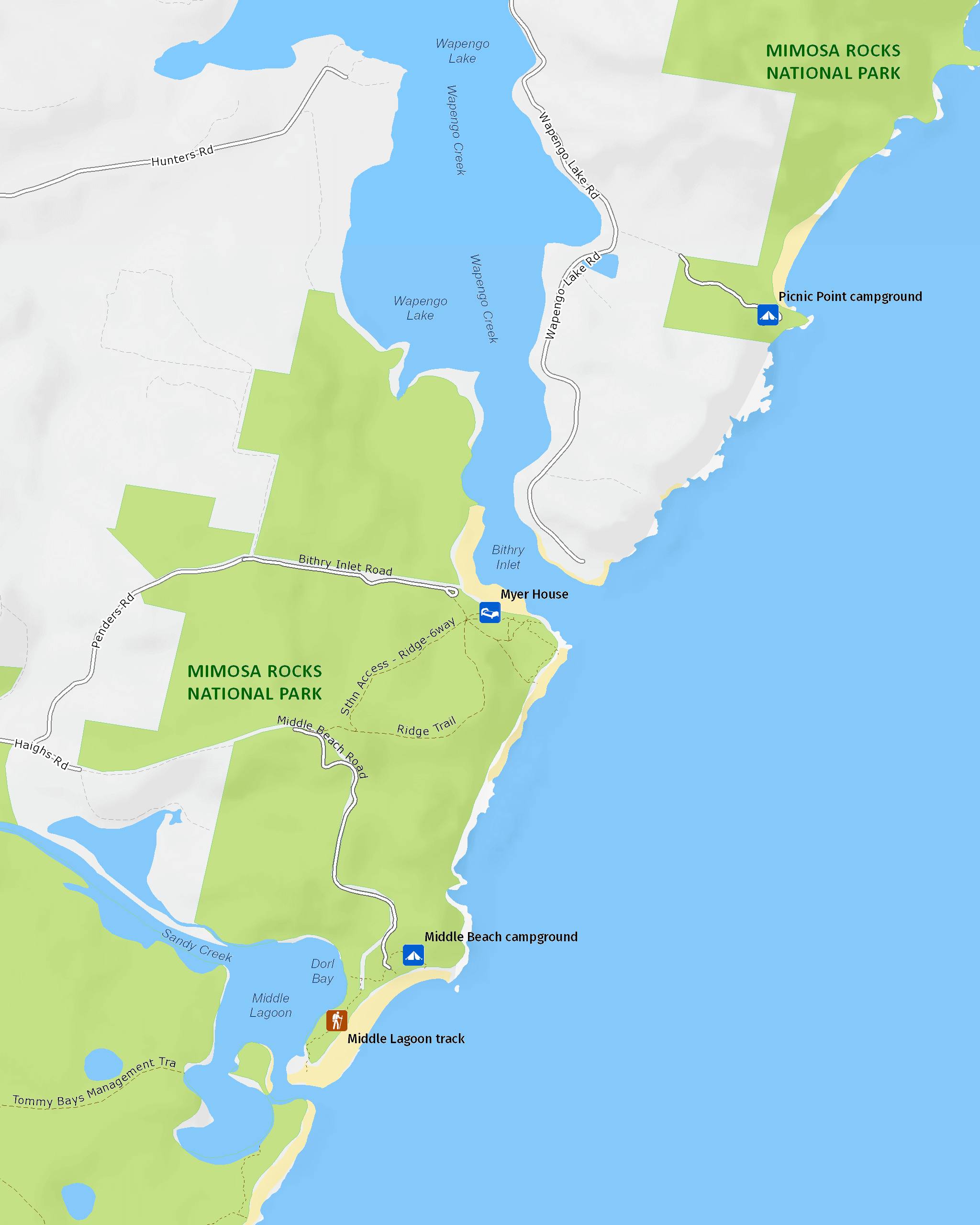
Map legend

Local alerts
For the latest updates on fires, closures and other alerts in this area, see https://www.nationalparks.nsw.gov.au/camping-and-accommodation/accommodation/myer-house/local-alerts
Bookings
- National Parks Contact Centre
- 7am to 7pm daily
- 1300 072 757 (13000 PARKS) for the cost of a local call within Australia excluding mobiles
- parks.info@environment.nsw.gov.au
Park info
- in Mimosa Rocks National Park in the South Coast region
Mimosa Rocks National Park is always open but may have to close at times due to poor weather or fire danger.
Visitor info
All the practical information you need to know about Myer House.
Getting there and parking
Myer House is in the middle of Mimosa Rocks National Park.
- Turn east off Bermagui-Tathra Road at Haighs Road then continue past the NPWS Tanja Depot, and head straight onto the dirt road (the road becomes Middle Beach Road) for 1.9km.
- Turn left off Middle Beach Road at the Myer House access gate
- Guests must contact the Caretaker a minimum of 24 hours prior to arrival to arrange for gate codes and access to the property
- Address: Myer House, Bithry Inlet, Penders Road, Tanja NSW 2546.
Road quality
- Unsealed roads
Vehicle access
- 2WD vehicles
Weather restrictions
- All weather
Parking
Off-street parking is available for five vehicles next to Myer House.
Best times to visit
There are lots of great things waiting for you in Mimosa Rocks National Park. Here are some of the highlights.
Spring
Head to one of the park's headlands for great whale watching – don't forget your binoculars for up close views.
Summer
A great time for a family camping holiday by the beach, try Aragunnu campground or Gillards campground .
Winter
Keep your eyes on the parks winter-flowering plants, like spotted gums, mugga ironbark and coastal banksia for honeaters and lorikeets.
Weather, temperature and rainfall
Summer temperature
Average
15°C and 27°C
Highest recorded
44.5°C
Winter temperature
Average
2°C and 18°C
Lowest recorded
-8.1°C
Rainfall
Wettest month
February and March
The area’s highest recorded rainfall in one day
454.2mm
Facilities
- Bedding configuration: 2 bedrooms with 1 x king size bed and 1 king single trundle. 1 bedroom with 1 x queen size bed. 1 bedroom with 2 x single beds. 2 x single sleep-out day beds in the enclosed verandah and 1 x double sofa bed in the kitchen/lounge area.
- The house is fully furnished with breakfast area, family room, central lounge/dining room and kitchen
- There is a tennis court with basic equipment, table tennis, a small library and a small collection of board games and playing cards.
- Myer House is not connected to mains water supply. Rainwater is collected in tanks and a filtered drinking water tap is available in the kitchen.
- There is a boat ramp and small jetty at Mogareeka on the Bega River just north of Tathra (around 15min drive from Myer House)
- Please ensure you leave the property in a clean and tidy manner with all dishes washed up and put away. Additional fees may be charged for any unreasonable cleaning required.
Toilets
Both bathrooms at the property have flush toilets. There is also a bidet in one of the bathrooms.
- Flush toilets
Picnic tables
There is a picnic table and benches just outside the enclosed verandah at the property.
Barbecue facilities
There is a gas barbecue with barbecue tools provided.
- Gas/electric barbecues (free)
Public phone
There is a land line phone at the property which can be used free of charge for local and emergency calls only. Mobile phone coverage can be poor and should not be relied upon.
Showers
Both bathrooms at the property have hot showers:
- The shower in one bathroom is wheelchair accessible.
- The shower in the other bathroom is combined with a bath.
- Hot showers
Electric power
Myer House is not connected to mains power. The power supply to the property is a fully integrated solar system with 240V inverter and diesel back-up generator.
Please be conservative with your power use and leave hair dryers and similar items at home. Fees apply for power outage call outs.
Indoor fireplace
There are 2 gas fireplaces in living room.
Kitchen
There is a kitchen with gas cooker, 2 fridges and a dishwasher. There is no microwave. Cleaning products are provided.
Plates and cutlery
Pots and pans
Bed linen
The beds have bottom sheets, pillows with slips, and doonas with covers.
Bath
One of the 2 bathrooms at the property has a combined shower and bath.
TV
There is a TV and DVD player
Washing machine
There washing machine and ironing gear.
Maps and downloads
Accessibility
Disability access level - hard
- Wheelchairs can access this area with some difficulty
- One bathroom has been refurbished to disabled access standards
- The design and construction of the Myer House pre-dated building accessibility standards, but would still be suitable for many visitors with disabilities or reduced mobility. Please contact NPWS Narooma office on (02) 4476 0800 to determine whether this accommodation meets your requirements.
Prohibited
Amplified music is not permitted.
Camp fires and solid fuel burners
Generators
Pets
Pets and domestic animals (other than certified assistance animals) are not permitted. Find out which regional parks allow dog walking and see the pets in parks policy for more information.
Smoking
NSW national parks are no smoking areas.
Learn more
Myer House is in Mimosa Rocks National Park. Here are just some of the reasons why this park is special:
Ancient connections
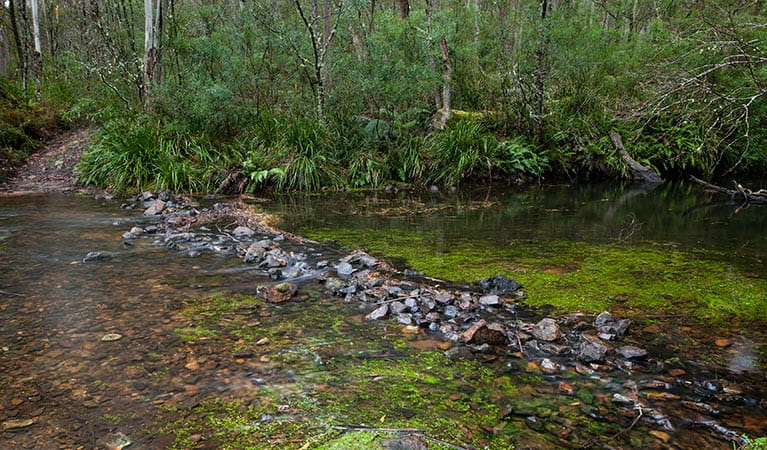
Mimosa Rocks National Park lies within the traditional Country of the Yuin people who have inhabited the region for thousands of years, climbing these headlands, swimming in the rivers and lakes, crossing the sand dunes and walking the beaches. The plants and animals within the park were a source of food, medicine and shelter for the Yuin people and the park's landscape is strongly connected to Dreaming stories. Be sure to take the Mimosa Rocks walk for an insight into the Aboriginal heritage within the park.
- Living Country living culture Join us for Living Country, living culture – a Stage 1 HSIE excursion in Mimosa Rocks National Park. An Aboriginal guide will help students understand the importance of culture and caring for Country.
- Living Country, living culture Join us for Living Country, living culture – a Stage 2 HSIE excursion in Mimosa Rocks National Park. In this cross-curricular program, an Aboriginal guide will help students understand the importance of culture and caring for Country.
- Mimosa Rocks walking track Great for walking with children, the easy Mimosa Rocks walk takes you along a short boardwalk to a lookout. You may spot the Mimosa shipwreck on the rocks below.
Bygone eras
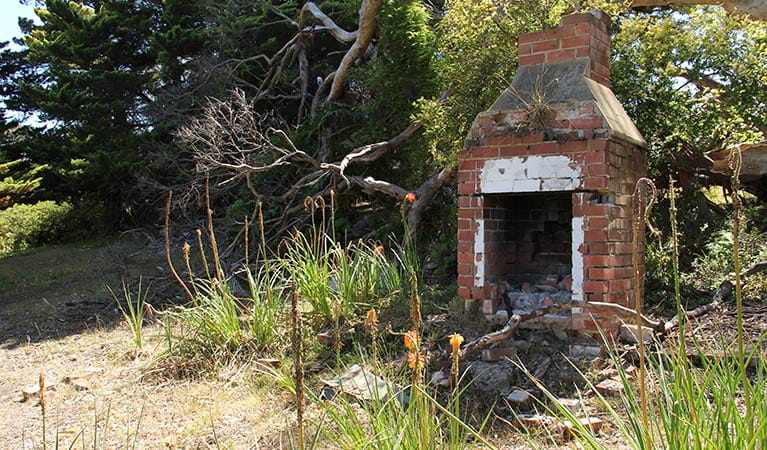
White settlers arrived in the Bega Valley in the 1830s, attracted by its grazing and farming potential, with Bega township being established in 1851. In its earliest years the town traders used Moon Bay as a regional port shipping Timber and sheep products from its sheltered waters. You can still see a log-slide and mooring ring from bygone days, or take a walk to 'Riverview' in the park's south-east, the remains of these historic premises have important associations with the 19th century timber and coastal shipping industries.
- Mimosa Rocks walking track Great for walking with children, the easy Mimosa Rocks walk takes you along a short boardwalk to a lookout. You may spot the Mimosa shipwreck on the rocks below.
- Moon Bay A short and easy walking track descends steeply to the secluded beach at Moon Bay in Mimosa Rocks National Park. Enjoy a picnic on the sand and explore the historic heritage of the area.
Plant spectacular
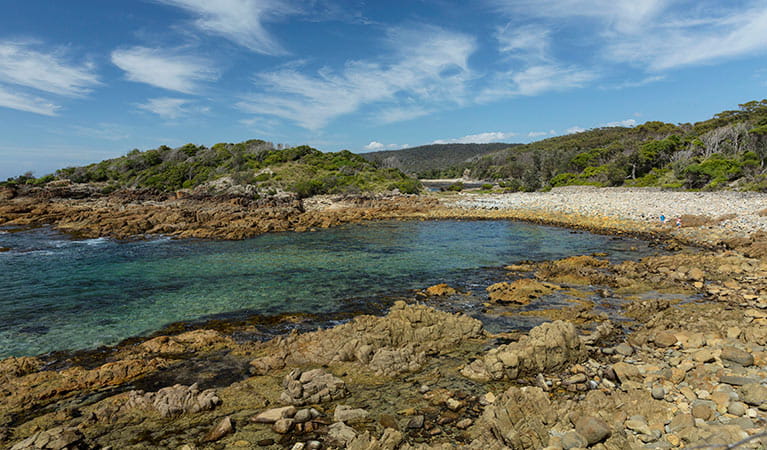
When you’re driving from the south and about to cross the Bega River, you are sure to notice the knife edge boundary of spotted gum, with an understorey of burrawang palms; characteristic vegetation of Mimosa Rocks National Park. When exploring the dunes and cliffs of the park you’ll see coastal banksia, coast wattle and drooping she-oak that can withstand winds and salty air. Check the gullies for the tubular flowers of the endangered chefs hat correa, so called because it’s a similar shape to a chef’s hat.
- Forest meets the sea guided walk Experience some of the best coastal views Mimosa Rocks National Park has to offer on this exciting guided walk with Navigate Expeditions.
- Merimbula guided photography tour Capture Merimbula’s stunning scenery on this unique tour guided by Mark Gray Gallery and Photography Tours. It’s a great way to learn new photography skills while exploring this magical area.
- Mimosa Rocks walking track Great for walking with children, the easy Mimosa Rocks walk takes you along a short boardwalk to a lookout. You may spot the Mimosa shipwreck on the rocks below.
- Moon Bay A short and easy walking track descends steeply to the secluded beach at Moon Bay in Mimosa Rocks National Park. Enjoy a picnic on the sand and explore the historic heritage of the area.
Wildlife haven
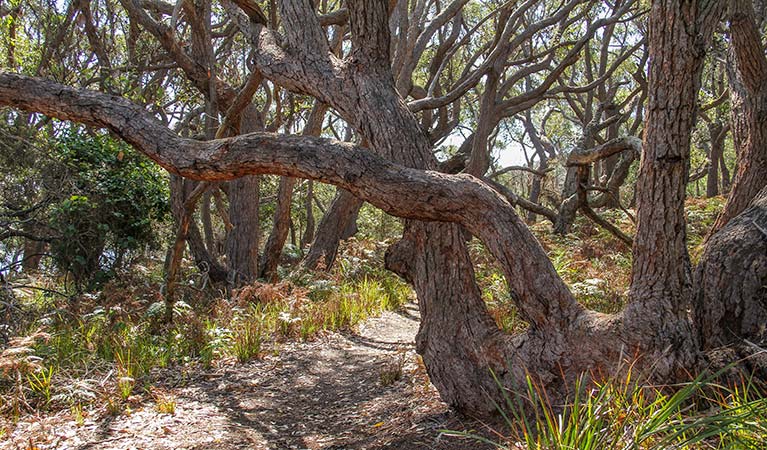
The park provides refuge for koalas, swamp wallabies and ringtail possums, to name a few. Of an evening at Aragunnu campground, you may not see yellow-bellied gliders flitting between trees, but you might be able to hear their distinctive cackling sound that cuts through the silence of the night. At Gillards campground you may well see a long-nosed potoroo. About the size of a rabbit, they look quite similar to a bandicoot, except that they hop in a similar way to a kangaroo. The potoroo is nocturnal, so you are most likely to see them in the evening. The park is an important stop for many migratory birds that nest along the park’s coastline. Look along the beaches and rock platforms – you may see threatened hooded plovers or pied oystercatchers. The bar-tailed godwit stops by briefly in summer during its migration from Alaska to New Zealand. It’s a well deserved stop off as the bar-tailed godwit makes the longest known non-stop flight of any bird and the longest journey without pausing to feed by any animal. Look for them around the park’s lakes and lagoons.
- Forest meets the sea guided walk Experience some of the best coastal views Mimosa Rocks National Park has to offer on this exciting guided walk with Navigate Expeditions.
- Wajurda Point lookout Wajurda Point lookout, in Mimosa Rocks National Park offers coastal and ocean views with seasonal whale watching opportunities.
Plants and animals protected in this park
Animals
-
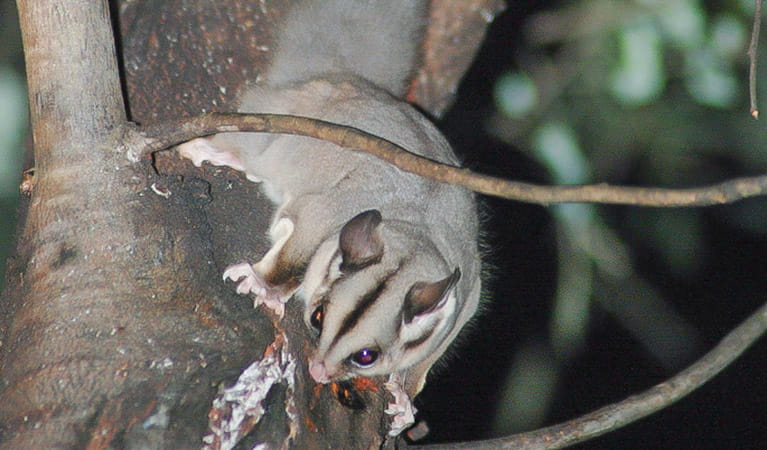
Sugar glider (Petaurus breviceps)
The sugar glider is a tree-dwelling Australian native marsupial, found in tall eucalypt forests and woodlands along eastern NSW. The nocturnal sugar glider feeds on insects and birds, and satisfies its sweet tooth with nectar and pollens.
Plants
-
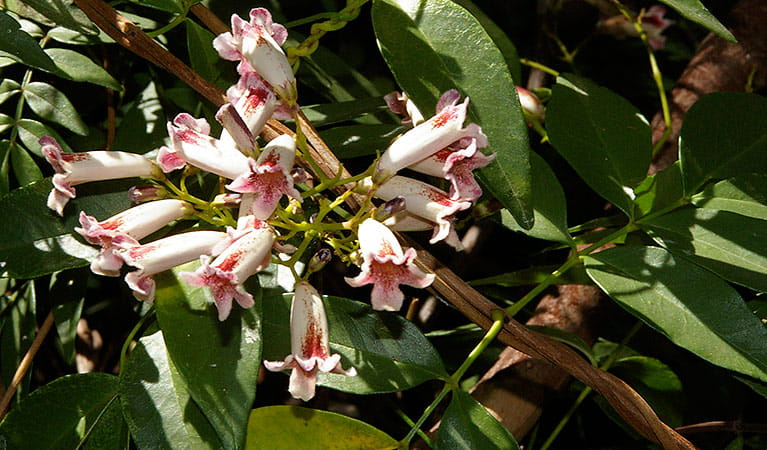
Wonga wonga vine (Pandorea pandorana)
The wonga wonga vine is a widespread vigorous climber usually found along eastern Australia. A variation of the plant occurs in the central desert, where it resembles a sprawling shrub. One of the more common Australian native plants, the wonga wonga vine produces bell-shaped white or yellow flowers in the spring, followed by a large oblong-shaped seed pod.
-
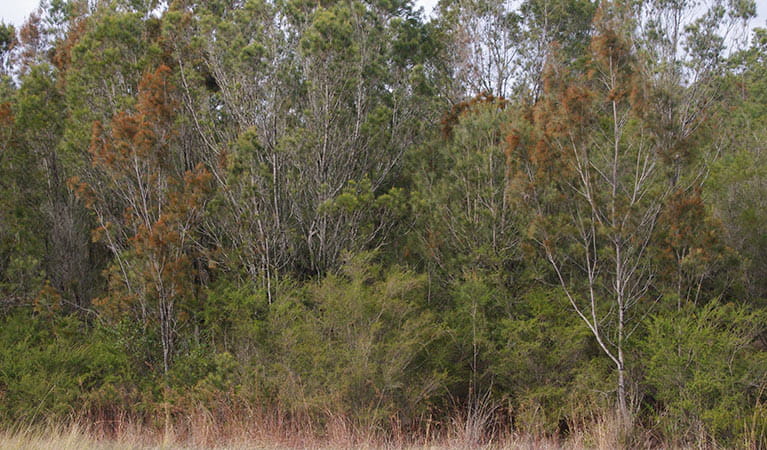
Black sheoak (Allocasuarina littoralis)
The black sheoak is one of a number of casuarina species found across the east coast of Australia and nearby tablelands. Growing to a height of 5-15m, these hardy Australian native plants can survive in poor or sandy soils. The barrel-shaped cone of the black sheoak grows to 10-30mm long.
-
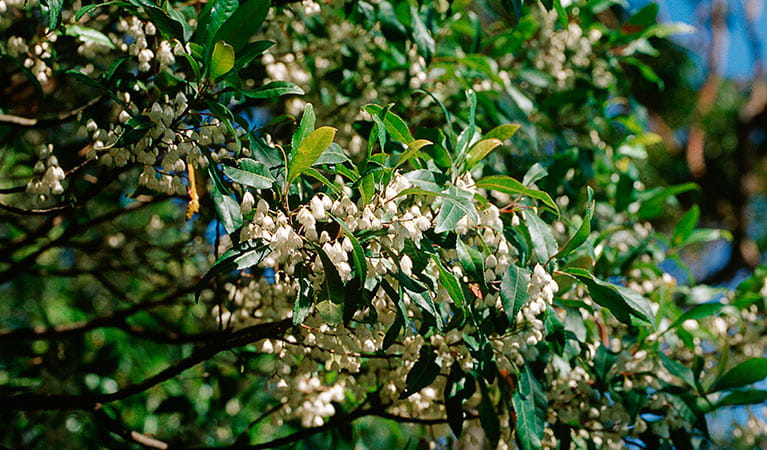
Blueberry ash (Elaeocarpus reticulatus)
The blueberry ash is a rainforest shrub which produces blue olive-shaped berries and spectacular bell-shaped flowers, which often appear on the plant together. It is a tall slender shrub or small tree found in rainforest, tall eucalypt forest and coastal bushland in eastern NSW, south-east Queensland and Victoria.
-
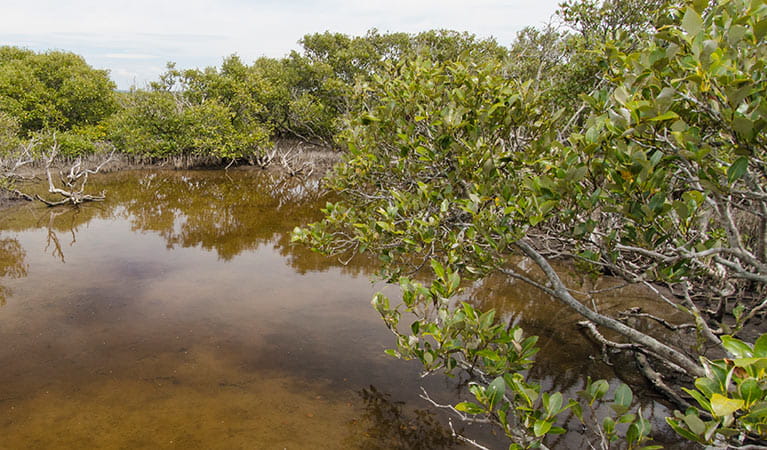
Grey mangrove (Avicennia marina)
Grey mangrove is the most common and widespread mangrove found within intertidal zones across Australia, and throughout the world. Growing to a height of 3-10m, they thrive best in estuaries with a mix of fresh and salt water. They excrete excess salt through their long thick leaves, and absorb oxygen through their aerial root system.

